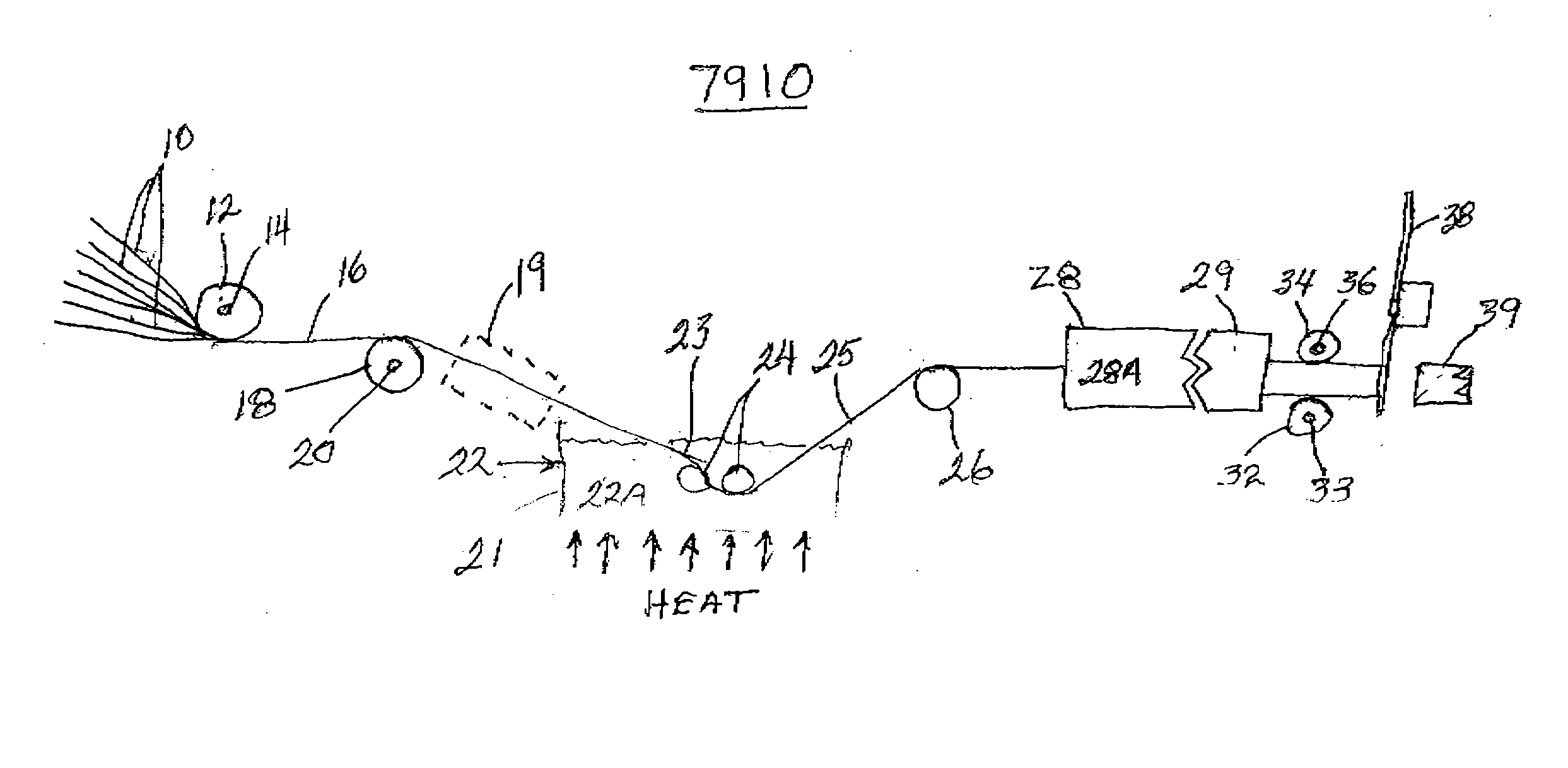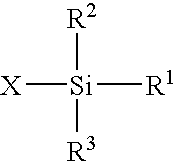Methods and systems for making reinforced thermoplastic composites, and the products
a technology of thermoplastic composites and reinforced thermoplastics, applied in chemical/physical/physical-chemical processes, coatings, chemistry apparatuses and processes, etc., can solve the problems of high tooling costs, limited use of thermoplastics for vehicle parts, and work done with thermoplastics, so as to improve the elevated temperature performance, reduce moisture, and improve the effect of stiffness
- Summary
- Abstract
- Description
- Claims
- Application Information
AI Technical Summary
Benefits of technology
Problems solved by technology
Method used
Image
Examples
example 1
[0036]Referring to FIG. 1, continuous, dry glass fiber strands 10, the glass fibers in the strands 10 having been previously sized with a sizing composition comprising an amount of 2-oxo-N-(3-(triethoxysilyl)propyl)azepane-1-carboxamide (compound 3 in reaction scheme A above) within the suitable range disclosed above, a conventional amount of any conventional organosilane normally used in glass fiber sizings, and a conventional amount of one or more conventional glass fiber lubricants conventionally used in glass fiber sizings, are pulled from a plurality of roving packages on racks (not shown) by the puller in the process. The glass fibers in this example are E glass fibers having an average diameter of about 20 micron. The glass fiber strands 10 are pulled over a multi-grooved guide roll 12 supported on a free wheeling mandrel 14 with one or more strands 10 being in each groove to spread out the strands 10 into a horizontal array 16 suitable for impregnation with a monomer-catalys...
example 2
[0038]This example illustrates the production of a glass fiber-reinforced polyamide-6 using a modified, according to the invention, resin transfer molding (RTM) process or a modified, according to the invention, reinforced reaction injection molding (RRIM) process. A glass fiber preform is made, having or approximating the shape of the desired product, at least in two dimensions, using any conventional manner except that the glass fibers in the glass fiber strands used in the glass fiber products making up the preform, chopped and / or continuous fiber strands, have been sized with a sizing composition comprising a sufficient amount of 2-oxo-N-(3-(triethoxysilyl)propyl)azepane-1-carboxamide, or other suitable silane coupling agent, 0-70 wt % of a polyurethane emulsion or a suitable mixture of emulsions, 10-50 wt % of a lubricant or mixture of lubricants, and optionally, 0-50 wt % of any other conventional required or desired additives. By sufficient amount is meant an amount that will...
example 3
[0042]Reinforced thermoplastic composite products can also be made using modified BMC processes. In this method, the thermoplastic precursor monomer(s), such as a lactam monomer, and one or more catalyst compounds as disclosed above, is heated to temperature range above the melting point of the monomer(s) and below the reaction temperature of the polymerization and placed into a BMC type or any mechanical mixer that can, optionally, also be heated or cooled. While the mixer is turning, reinforcement in the form of one or more of fibers, flakes and chopped strands of fibers, the fibers or flakes having on their surfaces one or more of the activator compounds, such as that used in Example 1, is slowly added to the monomer mixture while mixing until all reinforcement is added and thoroughly dispersed in the monomer mixture, to form a BMC compound. If desired, the temperature of this mixture can be maintained at the temperature of the monomer / catalyst mixture using either preheated rein...
PUM
| Property | Measurement | Unit |
|---|---|---|
| Fraction | aaaaa | aaaaa |
| Pressure | aaaaa | aaaaa |
| Temperature | aaaaa | aaaaa |
Abstract
Description
Claims
Application Information
 Login to View More
Login to View More - R&D
- Intellectual Property
- Life Sciences
- Materials
- Tech Scout
- Unparalleled Data Quality
- Higher Quality Content
- 60% Fewer Hallucinations
Browse by: Latest US Patents, China's latest patents, Technical Efficacy Thesaurus, Application Domain, Technology Topic, Popular Technical Reports.
© 2025 PatSnap. All rights reserved.Legal|Privacy policy|Modern Slavery Act Transparency Statement|Sitemap|About US| Contact US: help@patsnap.com



